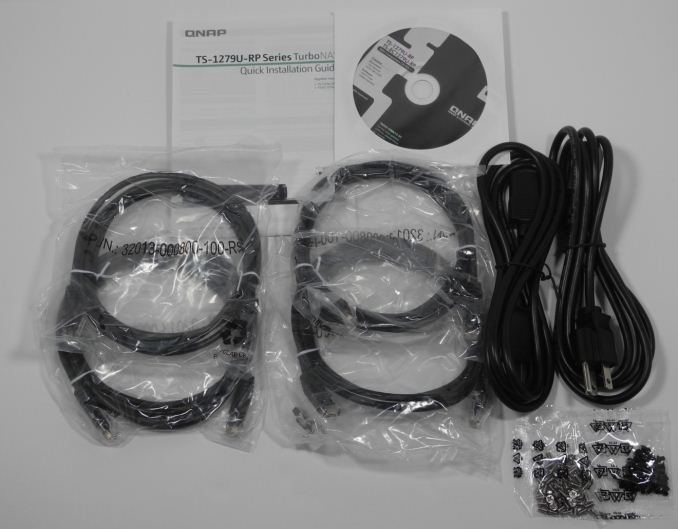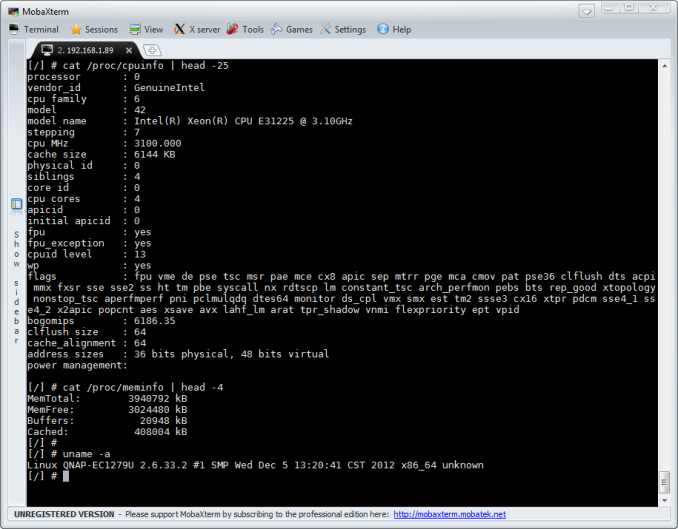QNAP's TS-EC1279U-RP 12-bay Flagship Rackmount NAS Review
by Ganesh T S on April 29, 2013 4:30 PM EST- Posted in
- Enterprise
- Storage
- NAS
- QNAP
Unboxing and Setup Impressions
The QNAP TS-EC1279U-RP package weighs in north of 50 pounds, with a diskless unit by itself coming in at 48 pounds (21.77 kg). As mentioned earlier, the unit is in the 2U form factor, with dimensions of 19" x 3.5" x 21". Along with the main unit, QNAP also bundles the following with the package:
- Quick Installation Guide and CD with QNAP utilities
- Four Cat 5e Ethernet cables
- Two US AC power plugs
- Screws for mounting hard disks in the drive bays
The front panel has twelve 3.5" drive bays arranged in three rows of four bays each. This leaves no room for a LCD display. The power button as well as status LEDs (network and power) are on the right side of the front panel. On the rear side, we have the VGA port for attaching a display, two USB 3.0 ports, two eSATA ports and four USB 2.0 ports. There are two GbE ports on the mainboard and two more on a half-height PCIe card. Two removable redundant power supplies round up the rear side of the unit. The power supplies are rated for 600 W each.
Inside the chassis, we have the E3-1225 CPU with a massive aluminium heat sink on top (passive cooling for the 95W CPU), one 4GB ECC DDR3 DIMM and a couple of spare SATA ports. The main board is isolated from the rear panel of the drive bays with three high speed fans which are user-replaceable (if the need arises). The SATA backplane consists of Marvell 88SE9125 SATA to PCIe bridges. There is one bridge chip for each SATA / SAS port, with a 6 Gbps SATA link on one side and a single PCIe 2.0 lane (5 Gbps) on the other.
On the software side, we found that not much has changed in terms of the UI since we reviewed the TS-659 Pro II. The setup process is very similar. There is an underlying assumption that the user / administrator is aware of various RAID levels (which is perfectly acceptable given the target market for this unit) as there is no automatic RAID level management. SSH access is available.
Even though multiple volumes can be created, a given disk can be a part of only one volume at a time. Disks can also be set up as hot spares. On the whole, the firmware has all the features that most IT admins would frequently use. In addition to the ability to configure the unit using the GUI, it would also be nice to have a CLI (command line interface) reference manual for this product level.
An overview of the setup process as well as the other features available in the current firmware is provided in the gallery below.
The firmware also comes with the ability to add more features using QPKG software expansion. There are a host of other features too, which we covered in detail in our review of the TS 659-Pro II. They are only of tangential relevance to this unit's target market, and hence, we won't go into detail into those features.
The disks can be set up in Single Disk, JBOD, RAID 0, RAID 5, RAID 6 or RAID 10 configurations. Available file systems are EXT3 and EXT4. Encryption is available on a per-volume basis.






























23 Comments
View All Comments
Jeff7181 - Tuesday, April 30, 2013 - link
EMC, Hitachi and NetApp provide enterprise class NAS and SAN arrays. This, nor any, QNAP product is anywhere near that level.Walkeer - Thursday, May 9, 2013 - link
agreed, plus NAS is not really enterprise anyway since these is SANdavegraham - Tuesday, April 30, 2013 - link
Ganesh,having worked in the storage industry (and now working for an enterprise and carrier networking company doing data center architecture and design) QNAP, Drobo, et al. aren't names that carry any weight for enterprise-class storage. The systems I deal with (for example, EMC Symmetrix VMAX 40K) are considered "enterprise class" storage systems (99.999% uptime, SSD caching and tiering, finely tuned atomic memory and storage access, multiple active processing storage engines/directors, fibre channel/FCoE/iSCSI front ends, extensive API command/control sets, replication [local & remote], snapshotting/cloning, etc.). As Jeff7181 notes below, these stand alone in a class by themselves.
cheers,
D
Walkeer - Thursday, May 9, 2013 - link
agreed, this is a SOHO toy...jaziniho - Wednesday, May 1, 2013 - link
Unless this comes in a model with dual controllers (not just dual PSUs), then it's squarely in the SMB rather than enterprise space.Support for SAS as well as SATA disks would also be high on list of potential requirements for enterprise. With RAID rebuild times on large drives so long, you need disks with decent reliability to give you more confidence in making it through the rebuild.
aloginame - Saturday, May 11, 2013 - link
I agree with the fact that this QNAP is not really a "Enterprise" or "High-End" solution for NAS, however, I have to disagree when it is being compared to something like EMC Symmetrix VMAX 40K, for those are really SAN solutions and not NAS.golemite - Monday, April 29, 2013 - link
Hi Ganesh, any chance of getting reviews of lower end rackmount NAS systems like the Synology RS812/812+?ganeshts - Wednesday, May 1, 2013 - link
We have the Synology RS10613sx+ in the pipeline, but it costs approx. twice that of the TS-EC1279U-RP and caters to users who require more performance / features.mmayrand - Tuesday, April 30, 2013 - link
So, you spend $3500 for box plus 12 SSD (not free) and you get the 1/3 of the effective bandwidth of a single SSD plugged in a $300 PC. Is there a point to these NAS boxes?davegraham - Tuesday, April 30, 2013 - link
Mmayrand,the concept behind a NAS box is shareable storage across N-number of users in a SoHo or SMB environment. at that point, it makes more sense to have a common pool of storage that can be "protected" (remember, RAID is NOT backup) and utilized more efficiently, than a scattered or siloed collection of independent disk in a laptop or desktop.
it also is a basic requirement for most virtualization (the concept of shared storage) solutions to maintain high availability and portability for virtual machines within a cluster. As a standalone box, you're right, you can hit better performance #'s because you're just straddling a PCIe bus vs. ethernet. however, change the venue and you're looking at a more ideal solution.
D